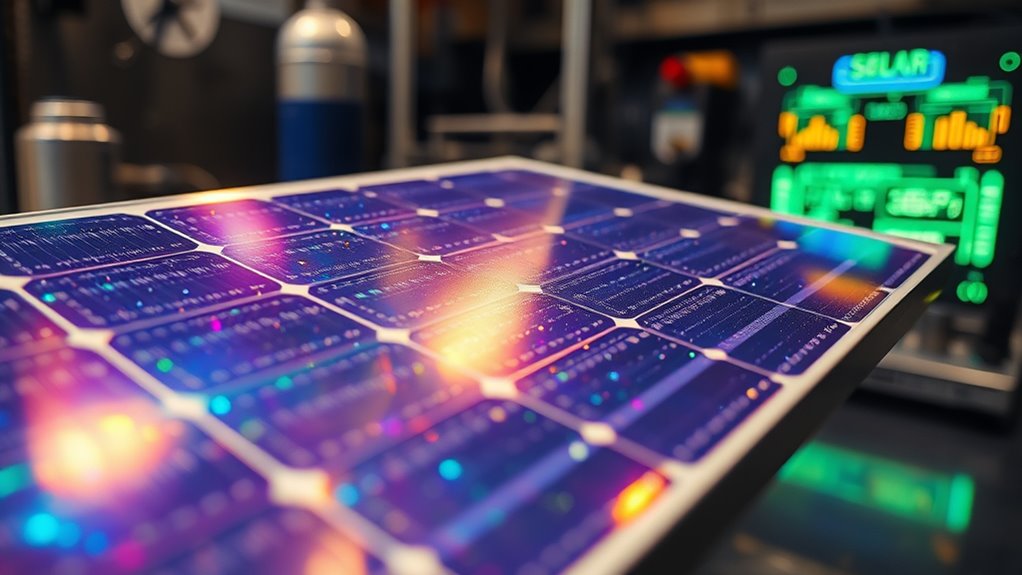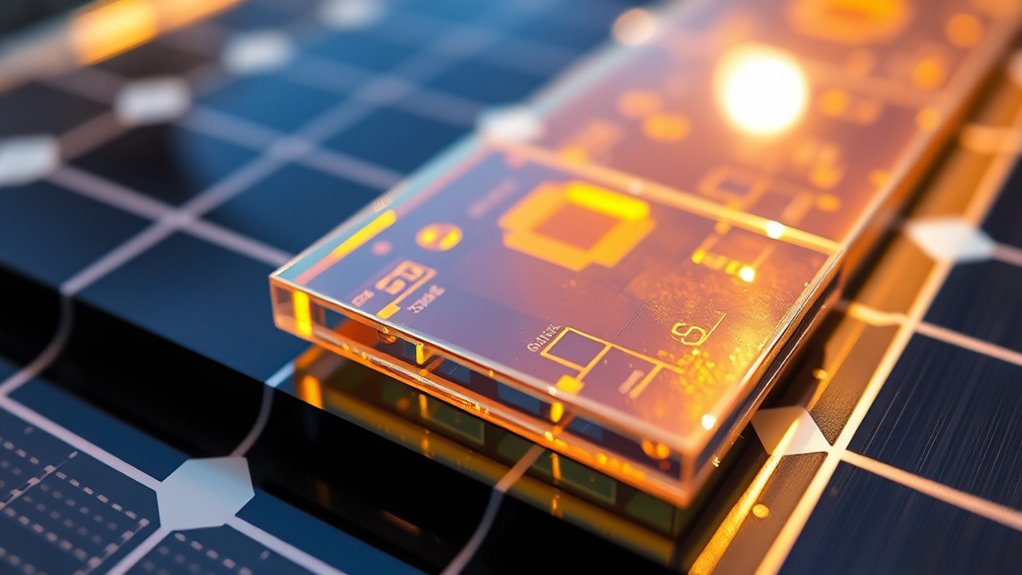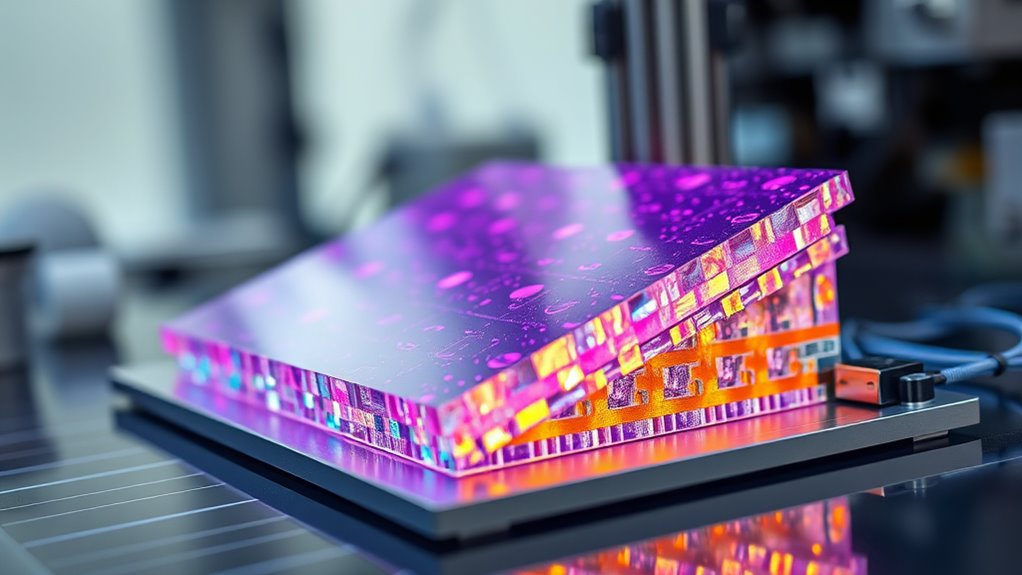Perovskite solar cells are reaching new efficiency heights thanks to breakthroughs in material stability, innovative tandem structures, and scalable manufacturing methods. Researchers are optimizing compositions like inorganic cesium lead iodide for durability and employing advanced device architectures to capture more solar spectrum. Scalable solution processing and layer engineering are making high-performance, flexible modules a reality. If you explore further, you’ll discover how these advances could transform solar energy into a more sustainable and affordable power source.
Key Takeaways
- Tandem structures combining wide- and low-bandgap perovskites achieve efficiencies up to 49%.
- Interface engineering and defect passivation significantly boost charge transfer and device stability.
- Layer and interface optimization enable high voltages and prolonged operational lifespans.
- Solution processing and scalable manufacturing methods facilitate large-area, high-quality perovskite solar modules.
- Innovations like sub-nanometer dipole layers and multijunction designs push efficiency limits beyond 25%.
Breakthroughs in Material Composition and Stability

Recent breakthroughs in material composition have markedly boosted the stability of perovskite solar cells. Researchers focus on optimizing perovskite materials, such as inorganic cesium lead iodide, to enhance thermal stability and resist phase degradation. Advancements in algorithms By designing advanced device structures with phase-heterojunctions, the stability and efficiency improve considerably. Interface engineering plays an essential role, with defect-passivating layers created through surface treatments like hexylammonium bromide, reducing surface recombination. Atomistic modeling shows that stable, coherent interfaces between different perovskite phases facilitate efficient charge transfer. Material stability An innovative research team has demonstrated that these strategies, combined with dual deposition techniques, lead to longer-lasting, more durable devices. Additionally, the development of encapsulation techniques further protects the perovskite layers from environmental factors, significantly extending device lifespan. Environmental stability These advancements bring us closer to commercially viable perovskite solar cells with superior environmental stability. Improved material design and surface passivation methods are critical to achieving these goals.
Innovative Device Architectures and Tandem Structures

Innovative device architectures, especially tandem structures, are transforming the potential of perovskite solar cells by surpassing the efficiency limits of single-junction designs. By combining wide-bandgap and low-bandgap layers, you can achieve spectral utilization and efficiency enhancement up to 49%. Two-terminal (2T) tandem devices utilize monolithic interconnection layers to connect subcells, while four-terminal (4T) structures stack cells independently, optimizing charge transfer. Layer engineering, including precise control of thickness and band alignment, minimizes recombination and boosts stability. Interconnection layers like polyTPD improve device longevity, while phase-heterojunctions further enhance efficiency. These innovations enable higher voltages and better stability, pushing perovskite tandem devices beyond 25% efficiency. Incorporating protective styling benefits from advanced layer designs can also improve device durability over time. Additionally, ongoing research into layer engineering techniques enhances control over material interfaces, further increasing device performance and lifespan. Advances in interface optimization contribute to reducing energy losses, thereby elevating overall device efficiency. Moreover, the integration of innovative material interfaces helps mitigate degradation mechanisms, extending operational lifespan.
Advanced Fabrication Techniques for Scalability

How can scalable fabrication techniques transform the production of high-quality perovskite solar cells?
By adopting solution processing, you can efficiently produce uniform, high-quality perovskite films suitable for large-area modules. Dual deposition, combining hot-air techniques and thermal evaporation, creates defect-minimized interfaces essential for scaling up. Solution processing offers a pathway to reduce manufacturing costs while maintaining high performance. Roll-to-roll manufacturing enables continuous, cost-effective production, making flexible, large-area modules feasible. These methods promote environmentally friendly, low-temperature processing, reducing energy use and material waste.
Solution processing enables scalable production of uniform, high-quality perovskite films for large-area solar modules.
Incorporating organic additives during fabrication improves film stability and crystallinity, ensuring durability at scale. Structural insights from modeling support these approaches, helping you maintain high efficiency and device performance across large surfaces. Additionally, understanding material stability and the interaction of additives can further enhance the longevity of perovskite solar cells during large-scale manufacturing. Implementing automated manufacturing systems can streamline production processes, increasing consistency and reducing manual errors.
Expanding Spectral Absorption and Efficiency Limits

Expanding the spectral absorption range of perovskite solar cells enables you to capture more of the solar spectrum, especially in the near-infrared region beyond 850 nm. This broadening boosts power conversion efficiency (PCE) by harvesting more infrared light, which traditional cells often miss. Techniques like integrating sub-nanometer dipole interface layers enhance charge transfer, improving device stability and spectral utilization. Additionally, implementing advanced material engineering can further optimize device performance and longevity. The development of durable materials ensures that these cells maintain high efficiency over extended periods, addressing one of the key challenges in photovoltaic technology. These innovations are driven by ongoing research into energy efficiency ratings and material properties, aiming to push the boundaries of photovoltaic technology. Now, you can achieve efficiencies up to 24.0%, capturing approximately 52% more solar energy. This advancement pushes perovskite’s potential in next-generation solar and photovoltaic technology. To visualize this progress, consider the table below:
| Feature | Impact | Result |
|---|---|---|
| Extended spectral absorption | Harvests more infrared light | Higher PCE |
| Charge transfer optimization | Improves device stability | Longer lifespan |
| Near-infrared light harvesting | Increases energy capture | Enhanced efficiency |
| Novel interface layers | Broader spectral utilization | Next-gen solar potential |
| Overall advancement | Surpasses traditional limits | Next-generation solar tech |
Emerging Applications and Future Perspectives

Emerging applications of perovskite solar cells are transforming the landscape of renewable energy, thanks to their lightweight, flexible, and versatile properties. These cells are now being integrated into building materials, space technology, and energy storage, capitalizing on their excellent light absorption and charge accumulation capabilities. Additionally, research into solar panel efficiency continues to push the boundaries of device performance. Future perspectives focus on improving stability through advanced layer engineering and encapsulation, ensuring long-term performance. Multijunction configurations aim to surpass 25% efficiency, with theoretical limits up to 49%, pushing the boundaries of what’s achievable. Scaling manufacturing processes like roll-to-roll solution fabrication is crucial for commercial viability and large-area deployment. Continued innovations in material engineering and interface passivation will be key to extending operational lifetimes and fostering widespread adoption of next-generation perovskite solar technologies. Moreover, considering privacy and cookie usage in the development of online platforms can enhance user trust and engagement with emerging technologies. As research progresses, optimizing device stability remains a central focus, ensuring that these innovative solar cells can meet real-world operational demands effectively. Emphasizing material durability is also critical for ensuring that the cells maintain high performance over extended periods in diverse environmental conditions. Furthermore, ongoing studies into environmental impact highlight the importance of developing sustainable manufacturing practices for these advanced solar devices.
Frequently Asked Questions
What Is the Efficiency of the Next Generation Solar Panels?
You wonder about the efficiency of next-generation solar panels. Currently, these panels have achieved over 25%, with some reports exceeding 26%. Researchers aim to push efficiencies above 30% by improving device design and materials.
Multi-junction tandem configurations could even reach 42% or higher under concentrated sunlight. These advancements promise significant improvements in energy conversion, making future solar panels more effective and sustainable for your energy needs.
What Is the Efficiency of Perovskite Solar Cells?
The efficiency of perovskite solar cells is like a race car reaching high speeds—you can see impressive progress. Currently, they convert over 25.7% of sunlight into electricity, nearing traditional silicon panels.
Advances in material design and device architecture drive these gains. You’re looking at theoretical limits around 33%, with tandem setups promising even higher.
Ongoing research aims to push beyond 25% in commercial devices while keeping costs and stability in check.
Is There a 30% Efficient Solar Panel?
You’re asking if there’s a 30% efficient solar panel. Currently, no commercial panels reach that level, but research shows it’s possible.
Perovskite solar cells, especially tandem types, can theoretically surpass 40% efficiency, making 30% achievable soon.
Advances in materials and design are pushing toward this goal, so while you won’t find a 30% panel on the market today, it’s likely coming in the near future.
Will Solar Panels Ever Reach 50% Efficiency?
Imagine chasing a rainbow’s end—that’s how close we’re to hitting 50% solar panel efficiency. Right now, you see, commercial panels hover around 25-26%. But with breakthroughs in tandem and multi-junction designs, you might witness this goal become reality.
Though hurdles like stability and cost remain, ongoing research acts as your compass, guiding you toward a future where solar power unleashes its full, shimmering potential.
Conclusion
You’re witnessing a revolution in solar tech, where perovskite cells push efficiency boundaries like the dawn of the industrial age. With breakthroughs in stability, innovative designs, and scalable fabrication, the future shines brighter than any medieval torch. As you embrace this next-gen energy source, remember that every step forward echoes the spirit of the Renaissance—where discovery and progress transformed the world, illuminating a sustainable path forward for generations to come.









